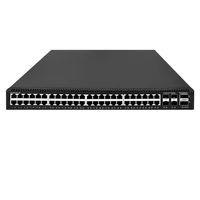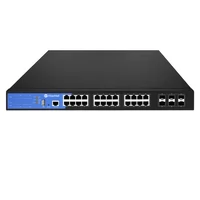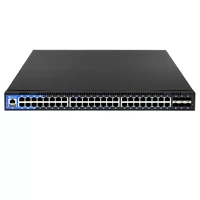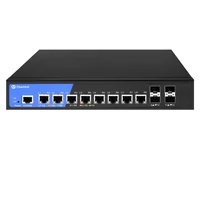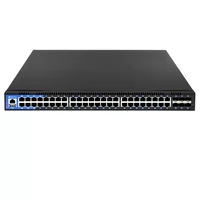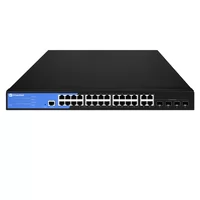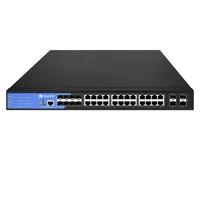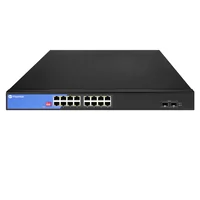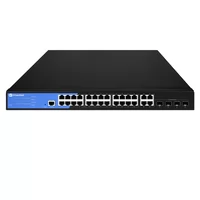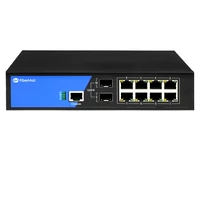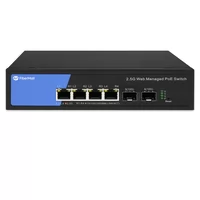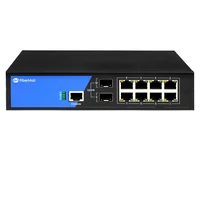Every home office setup would require reliable and efficient hardware to establish a secure work and internet connection, and most setups would include at least an 8-port Gigabit Ethernet Switch. Choosing the right switch, specially when setting up a new network from scratch, can boost connectivity, minimize bottlenecks in your network, as well as refresh the overall performance of the network. The current article attempts to cover everything you need to know about 8-port gigabit switches for informed decisions around purchasing them. From what features you look for to top-rated models on the market, the article aims to help the reader tailor their purchase to their networking needs.
Table of Contents
ToggleWhat is an 8-Port Gigabit Ethernet Switch?
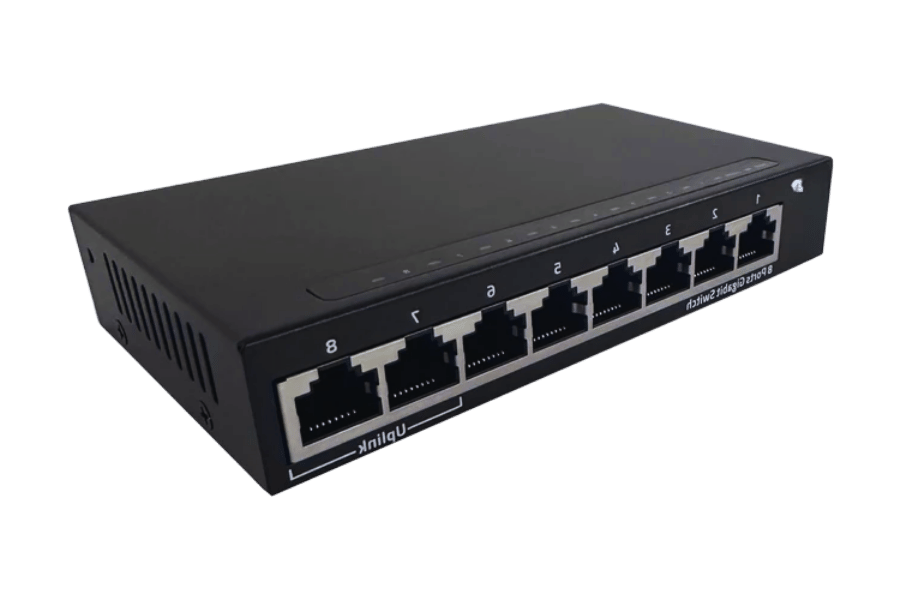
An 8-port Gigabit Ethernet switch (8-Port Gigabit Ethernet Switch) is a type of network switch used in a Local Area Network (LAN) to connect several devices at the same time. It has eight Ethernet ports, which can transfer data at Gigabit speeds (1,000 Mbps) per second, hence, a switch can connect, process data, and transmit computers, servers, printers, and other devices in the network. These switches are widely utilized for the enhancement of network infrastructure, optimization of data traffic, and efficient communication among connected devices. Their small dimensions, combined with what these devices offer, make them suitable for personal and business use in small to medium-sized networks.
Understanding the Gigabit Ethernet Technology
Gigabit Ethernet technology enables data transfer speeds of up to 1,000 Mbps, significantly faster than older Ethernet standards. This increase in speed allows for efficient handling of large files and high-bandwidth applications, such as video streaming or online gaming. It operates using advanced signaling methods to transmit data over copper or fiber-optic cables, ensuring minimal latency and reliable communication. By supporting seamless connectivity and high-speed performance, Gigabit Ethernet is widely used in both residential and enterprise networks to meet modern data demands.
Key Features of an 8-Port Gigabit Switch
For businesses and home office networks, an 8-port gigabit switch is perhaps the most crucial device for data transfer and connectivity. Some of its highlighted features include:
Connectivity
All ports are capable of handling up to 1 Gbps which allows seamless data intensive gaming, file transfers, or streaming. The switch itself also employs non-blocking architecture which ensures bandwidth is available at all ports simultaneously without any lag.
Plug-and-Play
Most 8-port gigabit switches can be plugged in and used right after installation. This ease of use enables network experts and nontechnical users alike to expand the network without much hassle. The device will start forwarding network traffic once plugged in, with no setup required.
Environmentally Friendly
The addition of energy-saving features in modern switches, such as IEEE 802.3az (Energy Efficient Ethernet), results in more environmentally friendly products. These features, among others lower power consumption and energy traffic by scaling energy spend when needed or shutting down unused ports.
Network Segmentation VLAN Support
Advanced models allow for the creation of virtual Local Area Networks, which allow administrators to segment networks, aiding in traffic management, security, and congestion.
Quality of Service (QoS)
QoS functionalities are very beneficial in multi-device environments as they prioritize critical data traffic for smoother performance on VoIP calls, video calls, and online games.
The absence of fan mechanics ensures maintenance free quiet operation, ideal in both home and office settings.
Most 8-port Gigabit switches are made using durabale materials and designed with a compact form factor that can be used within small spaces like home offices, server rooms and entertainment units.
Advanced port security features such as DoS attack prevention and secure management protocol are often included in the switches to protect network data and infrastructure from malicious activities.
The ability to connect numerous devices such as computers, servers or IP cameras ensures the 8-port Gigabit switch provides flexible scalability for expanding a network without compromising performance.
Long term warranties and technical support from reputable manufacturers helps ensure customer satisfaction so long as the 8-port Gigabit switches maintain power, performance and reliability as fundamental parts of modern networking solutions.
Benefits of Using an Ethernet Switch in Your Network
Enhanced Network Efficiency
The performance of a network is greatly enhanced by Ethernet switches, which lower the data transfer collisions while increasing the transfer rates. They guarantee full-duplex communication, which allows two-way data transfer simultaneously, thus increasing the throughput to twice as much as that in half-duplex systems. For example, gigabit Ethernet switches enable the transfer of data at the speed of 1,000 Mbps, meaning large files can be transferred almost instantly and videos can be streamed without interruption. They are thus best suited for today’s networks that require high bandwidth.
Flexibility and Scalability
Ethernet switches are flexible as they allow for scalability, giving users the capability to expand their network construction when need arises. The number of ports vary from 5 to 48 which makes these switches suitable for both simple home configurations and complicated networks within enterprises. Managed switches give additional flexibility and security through proper network control, offering VLANs, Qos and monitoring.
Decrease Network Congestion
Ethernet switches reduce congestion by creating point point connections between different devices. For example, switches can use MAC addresses to direct packets to specific ports for next hop devices, so instead of sending the frames to every device on the network like hubs do, switches intelligently broadcast which improves performance for everyone even in heavy traffic situations.
Energy Consumption
Many modern appliances, like Ethernet switches, have advanced features whichhelp save energy, like the IEEE 802.3az (Energy Efficient Ethernet). This feature, among others, lowers energy usage, optimizing costs, by dynamically changing required power based on network usage. For instance, unused ports are capable of being powered down, translating to easily lowered costs for companies.
Improved Protection Against Cyber Attacks
Managed Ethernet switches come with robust data protection capabilities to defend sensitive information. Network administrators can be granted the ability to create Access Control Lists (ACLs), port security and encryption barriers to defend against Access Control and Cyber Security breaches. Moreover, real-time automated threat defense and notification capabilities are available does some switches, allowing for risk mitigation in real-response.
Affordability
Building dependable, reliable networks with Ethernet switches is budget-friendly, proving Ethernet switches offer solutions with minimal principles expenditure. Different configurations are available, and their durability paired with low servicing required, ensures a solid return on investment. Poised with numerous benefits, modern switches also offer built-in features such as Power-over-Ethernet (PoE), which removes the necessity for external power cables, minimizing installation costs.
During today’s data-oriented times, incorporating Ethernet switches into enterprises proves promising. With speed, stability, and security improvements for the network infrastructure in place, these devices become essential for reliable networking systems.
How to Choose the Right 8-Port Gigabit Desktop Switch?

Comparing Managed vs. Unmanaged Switches
The use-case scenarios, control, and functionality differ significantly between managed and unmanaged switches. Managed switches offer advanced features such as VLAN support, redundancy protocols, monitoring tools, and Quality of Service (QoS) settings. Network administrators may use these features to optimize performance, enhance security, and fine-tune traffic flow, making managed switches more ideal for larger, complex networks or organizations for tailored supervision. Web-based interfaces and command-line interfaces enable updates and configurations to be set; however, managed switches come at a greater expense, and with higher requirements for configuration and maintenance than unmanaged switches.
Less advanced than managed switches, unmanaged switches are generally more cost-effective. Without requiring any alterations, unmanaged switches allow for plug-and-play use. Automatically directing traffic between connected devices streamlines advanced customizations, ideal for small networks or home setups. Although simple applications don’t require features such as detailed monitoring and traffic prioritization, unmanaged switches offer straightforward performance.
Managed switches currently retail for $150 to over $500 for 8-port models, depending on their capabilities. Unmanaged switches are much cheaper, costing $20 to $80 for the same number of ports. Unmanaged switches are ideal for small businesses or users with minimal networking skills due to their simplistic design and low costs. Meanwhile, large companies or expanding networks will always benefit from managed switches due to the control and flexibility they provide to adapt to changing demands. Paying attention to your organization’s size, needs, and budget is crucial to selecting the right option.
Importance of Power Over Ethernet (PoE) in Switches
The ability to send data and power simultaneously through a single Ethernet cable makes Power Over Ethernet (PoE) technology a valuable addition to any network switch. PoE power delivery functionality IT devices like IP cameras, VoIP phones, and other wireless access points, streamlining the infrastructure at pre-existing sites and lessening maintenance demand and direct installation costs.
Additional updates to PoE with the August 2019 IEEE 802.3bt standard increased power delivery capability to 90 watts per port. This added functionality increases the number of devices able to be connected, such as sophisticated surveillance cameras, advanced LED lights, and potent IoT devices. Furthermore, PoE switches facilitate remote power control, which allows for improved energy management, monitoring, and troubleshooting of power usage.
Industry analyses suggest that the global PoE stood at approximately $600 million market value in 2022 and is expected to reach over $3 billion by 2027, which is focused on smart building technologies and 5G developments. Additionally, PoE enables an effective network device load redistribution system that handles requirements automatically based on device needs. This makes PoE switches vital for contemporary networks designed to enhance efficiency while responsibilities.
Considerations for Home Network and Business Use
While integrating Power over Ethernet (PoE) into Networks for homes or businesses, specific elements require discussion to ensure optimum performance and future expansion. In the case of home networks, PoE permits device connections without the requirement for additional electrical outlets next to security cameras, access points, and smart home hubs. Recent industry PoE adoption data cited indicates smart security devices’ PoE adaptations in household setting will grow by twenty-one percent annually through 2028, owing to installation ease and fuel savings.
In the case of business networks, PoE is extremely helpful for IoT applications and expansive office layouts. One notable development is PoE++, which allows 90W power per port. This advancement enables the functionality of high-end devices like intricate video conferencing systems and digital signage. Moreover, approximately forty-two percent of businesses are estimated to internally upgrade their networks to PoE for 6E wireless deployments, cited as enabling improved operational flexibility.
Both settings are aided by the cost effective strategies pertaining to device monitoring and diagnostics which power management offers. The network’s PoE switches meeting the necessary power budget, as well as having the ability to scale in the future, serves as a major concern for residential as well as commercial users.
What are the Advantages of Smart Managed Switches?
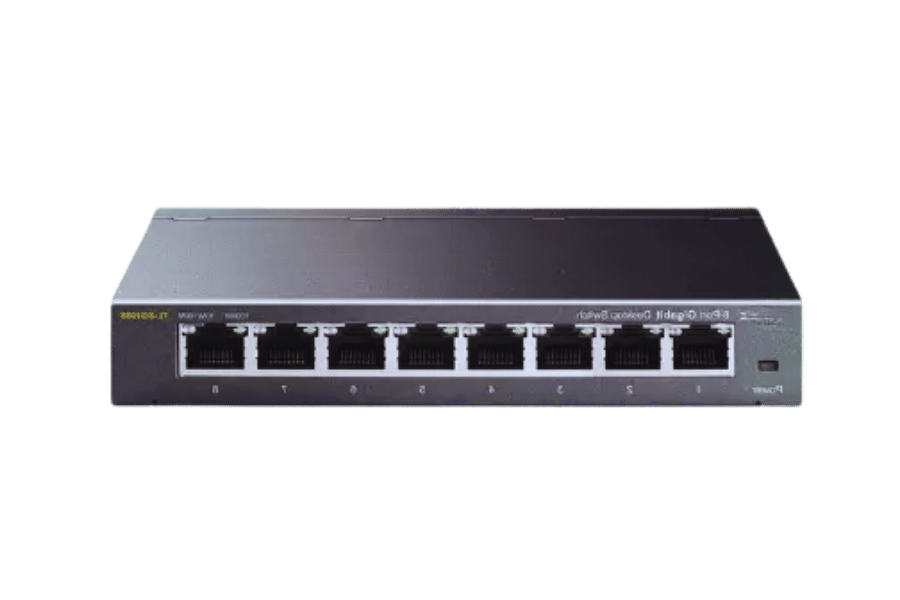
Exploring Smart Managed Features
Smart managed switches strike a delicate balance between basic unmanaged switches and fully complex managed switches. They come equipped with crucial elements such as VLAN support, quality of service (QoS) settings, and relevant network monitoring capabilities for improved control and optimization. Enhanced control ensures these switches are tailored for small to medium-sized networks as they provide simplified configuration while still possessing fundamental management functions. Smart managed switches are designed with easy-to-use interfaces along with multiple scalable options which ensure trusted performance in numerous environments.
How VLAN and QoS Enhance Network Performance
VLANs (Virtual Local Area Networks) enhance network performance by optimizing the segmentation of traffic, resulting in reduced network congestion and isolation of devices to limit broadcast domains. This ensures optimum utilization of bandwidth and also improves security by providing targeted access to specific network segments.
QoS (Quality of Service) further protects critical information by safeguarding the functioning of essential applications, including voice, video, and real-time services. With VLANs configured properly, there is minimal latency, jitter, and packet loss, allowing for greater control of network resources. Traffic types deemed non-essential receive lower priorities. QoS works to strengthen VLAN operations, and together they holistically simplify the management and control of networks while enhancing the level of dependability and efficiency of the network services provided.
Setting Up Your 8-Port Gigabit Ethernet Switch
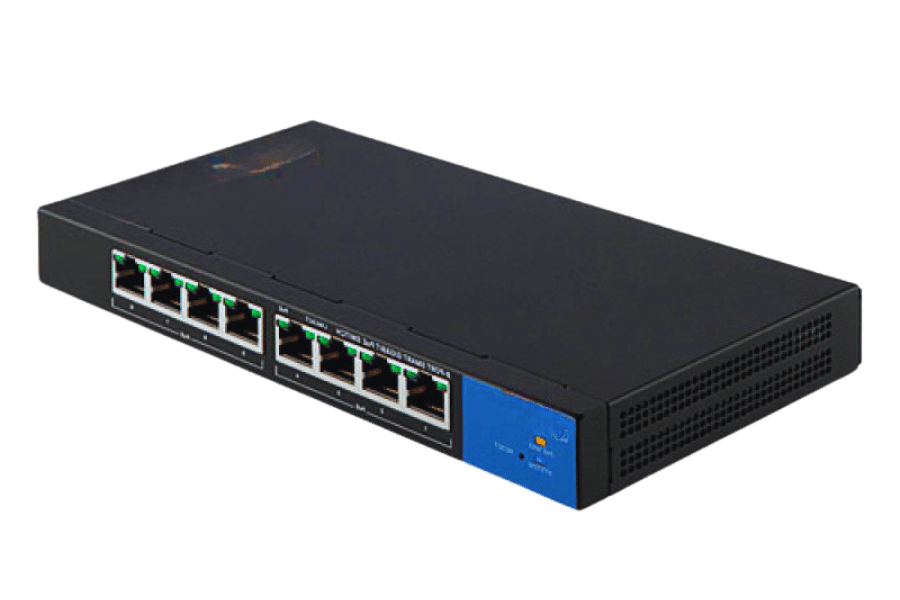
Step-by-Step Guide to Plug and Play Installation
Achieving excellent network efficiency effortlessly begins with properly setting up your 8-port Gigabit Ethernet Switch. Simply adhere to the guidelines provided below for a flawless, seamless setup.
Unpack the Switch
Start packaging the appliances as you locate the Ethernet switch. Accompanying it should be a power cord, an instruction guide, and other associated materials in the box. Make sure each item is intact and none of them are broken.
Select An Installation Location
Look for a horizontal site that has enough space free of obstruction that has good airflow. Do not place the switch directly in the warm sunshine or near overly dusty and wet areas. Overheating is a problem when combined with poor placing. Wall mounting brackets can be used too, and should be placed correctly for this position.
Power Up the Switch
The provided power adapter can be plugged into a nearby AC outlet. Afterward, it should be placed into the switch’s power port. Now the adapter should be plugged in, and in doing so, the switch LED will turn on, indicating that it is receiving power, which is a good sign. Newer models are successful ultra-low power tecnología is when the idle ports’ automatic shutoff mode kicks in.
Plug Ethernet Cables
For the best results, utilize Cat5e or Cat6 Ethernet cables. For devices that you want to connect such as wireless access points, printers or computers, plug one cable into each device. Cables should be plugged directly into any of the eight ports on the switch. Be careful not to over tighten the connections since that could damage the ports, but make sure the connections are seated properly.
Set up as a Router
In order to share internet across multiple devices, plug one of the Ethernet cables into any port on the switch, and connect the other end to the LAN port on the router. This will allow all devices connected to the switch to utilize the internet.
Check LED Indicators
Most switches are equipped with LED indicators for each port that show the connection status and speed, along with link activity (10/100/1000 Mbps). Connection status is usually green and amber, or blinking indicates activity, while the device could be connected to lower speeds.
Enable Additional Settings as Needed
For more advanced settings like VLANs or QoS, check the user manual to navigate to the switch’s web interface or management software. These configurations might need the default login credentials from the provided manual, but they do permit traffic optimization and tailoring the network as required.
Test The Network
Upon completing the physical connections, you should be able to access the internet and transfer files between connected devices. Make sure that all operations complete within an acceptable time frame.
Maintain and Monitor the Switch
Schedule periodic maintenance, including cleaning, for optimal operational conditions. Apply any relevant firmware updates, where available, to strengthen system security and enhance performance.
Carrying out the steps above will ensure that your 8-port Gigabit Ethernet Switch is fully configured to create an excellently responsive access point to the network infrastructure and a reliable backbone for sensitive information router.
Connecting Ethernet Cables and Devices
In connecting various Ethernet devices, I would first make sure all the devices are switched off so that no damage is caused. After this, I would take an Ethernet cable, then connect one end to the port designated on the switch and the other end to the Ethernet port of the device I wish to connect. I would repeat this for all devices that need network access. After all the appropriate connections are made, I would turn on the switch along with the other devices, which will then allow the devices to communicate and sync with the network.
Optimizing Bandwidth and Network Traffic
Effective optimization of bandwidth and network traffic is essential to operating a high-performing, dependable network, especially due to the rising demand for data and interconnected devices. One of the main initiatives is the implementation of Quality of Service (QoS) policies. QoS allows critical data, such as voice and video information, to be transferred with subnetwork latency and loss of data packets. Studies indicate that the application of QoS policies can decrease latency by thirty percent, enhancing the performance of applications that depend on the exchange of information in real time.
Another critical approach is the application of load balancers. Load balancers increase efficiency by ensuring that no single server or path becomes a point of restriction or congestion while traffic passes through it. For instance, adaptive load balancing algorithms respond to peak resource usage by improving response times by forty percent, leading to dynamic resource allocation.
Bundling data is another approach to reducing the amount of bandwidth consumed. The total amount of data to be transmitted is reduced when files and protocols are compressed before the transfer. The speed of communication is increased with no increase in capacity. Gzip and such protocols can enable documents to be seventy percent smaller, which is advantageous when large information sets are sent in depensed bandwidth settings.
Network monitoring plays a crucial role in traffic management and bottleneck detection. Some high-level tools like deep packet inspection (DPI) facilitate the analysis of traffic patterns in real-time, allowing administrators to detect issues and apply fixes before serious problems arise. Recent reports suggest that organizations employing DPI have experienced network downtimes that are, on average, 25% lower than those of organizations that do not.
Finally, placing the computation tasks at the edge of the network while still retaining some connection with the core IT infrastructure allows for dealing with the associated data streams, thus relieving the primary network infrastructure. Since edge computing performs functions at the location of a device, it is a great fit for IoT settings since it reduces latency and alleviates strain on the core network. Combined together, these approaches allow for effective optimization of the bandwidth and network traffic in the living digital networks of today.
Top Brands and Models of 8-Port Switches

Reviewing Popular Netgear and TP-Link Options
Netgear GS108 8-Port Gigabit Ethernet Switch
In small office or home office environments, networks require an unmanaged switch that provides seamless connectivity—the Netgear GS108 is up to this task as an 8-port gigabit switch. Designed with 8 Gigabit Ethernet ports, the GS108’s speed sensing abilities, auto-negotiation, and auto-uplink technologies simplify setup, reducing both installation time and effort, making this switch automatic. Its fanless operation guarantees zero noise, and compliance with IEEE802.3az energy efficiency standards ensures eco-friendly performance. The plug-and-play GS108 chassis delivers robust reliability for long-term sustained use, alongside its durable metal chassis. Providing up to 16 Gbps, the GS108 proves to be reliable with bandwidth-intensive tasks, simplifying overall network demands, ensuring effortless seamless operation.
Netgear GS308E Smart Managed Plus
GS308E features an improvement over basic unmanaged switches, incorporating essential Layer 2 management features such as VLAN support and QoS (Quality of Service) for small networks that require traffic priority. Like the other model, it features 8 gigabit Ethernet ports, but this model provides GS308E managed configuration through Netgear’s web interface, ensuring simple browsing. Port-based and 802.1Q VLAN security enhances flexibility in network segmentation, and the GS308E provides better reliability without compromising speed. Ideal for small-scale business networks, this model provides affordability without sacrificing functionality.
The TP-Link TL-SG108 8-Port Gigabit Ethernet Switch
The TP-Link TL-SG108 is an inexpensive unmanaged switch that provides gigabit connections on 8 ports with a total potential bandwidth of 16 Gbps. It has Green Ethernet technology that saves 82% of power consumption, lowering the cost and providing efficient performance. The robust metal casing provides long-lasting durability, the fanless design allows for no noise operation, and it can automatically adapt to high-speed networks thanks to its plug-and-play compatibility. This model is perfect for home users or small businesses with its simple yet effective high-speed networking solutions.
TP-Link TL-SG108E Easy Smart Switch
The TP-Link TL-SG108E is an Easy Smart Switch featuring basic management capabilities such as VLAN, traffic monitoring, and QoS. Its 8 Gigabit ports ensure full dux throughput in fast data transfer rate while still maintaining a compact form and sturdy metal casing and the web UI offers seamless configuration. This is ideal for small office networks that require segmented traffic management or prioritization of critical streams.
Both Netgear and TP-Link provide outstanding 8-port switches ranging from simple plug-and-play unmanaged ones to smart switches with basic management functions. Users can choose depending on the complexity of the network, power consumption, and integrated features.
Choosing Between Desktop and Rack-Mount Models
Each environment has its own requirements, distinguishing between desktop and rack-mount network switches. Desktop switches are portable for small to medium-sized networks, perfect for scheme offices as well as small to medium businesses. They are easy to set up, operate quietly and take up limited space. An example of an unmanaged desktop switch is TP-Link TL-SG108 which is renowned for its plug and play productivity alongside energy-efficient design.
On the contrary, rack-mount switches target larger, complex networks which are found at enterprises or server rooms with central management needs and high scalability. These switches are more customized, built into standard twenty-inch server racks, and offer features like VLANs, QoS, and PoE. Alongside these features, they tend to supply more than 48 ports, enabling them to support a huge capacity of wired connections. An example of a rack mount switch is Netgear GS310TP.
Critical issues encompass spatial allocation, cooling needs, and technical specifications. Due to data center-grade rack-mount switches having higher data throughput capabilities, they may need dedicated cooling solutions, compared to desktop switches, which operate at a lower power and heat consumption. Cost is another differentiating factor; basic desktop switches are less expensive, but basic applications for rack-mount switches incur large-scale investments while providing significant value for large-scale deployments.
Understanding the Role of SFP Ports in Network Expansion
The role of SFP (Small Form-factor Pluggable) ports is to widen a network’s range because they enable the use of different types of transceivers to link devices on different networking standards and distances. These ports accept fiber optic and copper connections, giving flexibility in extending the network distance. Utilizing SFP modules, an organization can scale its networks to link to geographically remote locations or merge with high-speed backbones without making considerable changes to supplemental hardware. Due to their modular nature, SFP ports allow simpler network upgrades and adaptations, which makes them crucial for modern network architectures that need to be expanded easily.
Frequently Asked Questions (FAQs)

Q: What is an 8-port gigabit Ethernet switch, and how does it benefit a home or office network?
A: An 8-port gigabit Ethernet switch is a networking device that connects a high number of network devices, offering a speed of 1000 Mbps per port. This device is beneficial for homes and offices as it provides high-speed data transfer as well as dependable wired connections. It also facilitates high-definition videos and online multiplayer games.
Q: What is the importance of IEEE standards in Ethernet switches?
A: Different network devices may require compatibility and interoperability, and IEEE standards provide that. Ethernet switches that follow IEEE standards, such as IEEE 802.3 for Ethernet, have trustworthy connections and will make their use add value regardless of the devices or manufacturers.
Q: How does a switch with 2 SFP ports differ from a standard 8-port gigabit switch?
A: A switch with 2 SFP ports adds the capability of plugging in small form factor modules (SFP) with fiber optic connections. That allows the network to go beyond standard copper Ethernet, which makes it easy to connect to remote network sections and high-speed backbone networks.
Q: What are the advantages of using an 8-port gigabit smart managed switch?
A: The 8-port gigabit smart managed switch provides advanced functionalities like VLANs, QoS, and port mirroring for better traffic control management. It enhances the flexibility and performance of small to medium business networks or sophisticated home networks.
Q: Can an 8-port managed switch support PoE devices?
A: Yes, most 8-port managed switches are equipped with PoE features, enabling them to transmit data and power via an Ethernet cable. This simplifies the installation for IP cameras, wireless access points, and VoIP phones, which have to be installed in locations without easy access to power outlets.
Q: What does energy efficient Ethernet mean in the context of network switches?
A: Energy-efficient support in Ethernet devices lowers the energy costs by intelligently managing power consumption based on the data traffic. This attribute is beneficial for both households and offices because it reduces operational expenses and enhances energy efficiency.
Q: How does a gigabit unmanaged switch differ from a smart switch?
A: Gigabit unmanaged switches are basic plug-and-play devices while smart switches offer more configurability. The unmanaged switch requires no set up but simply plugs in which is ideal for basic connectivity needs. Smart switches, like the name suggests, include configurable VLANs, QoS, and link aggregation, therefore providing more control over performance optimization.
Q: What are the benefits of link aggregation in an 8-port network switch?
A: Link aggregation allows multiple individual Ethernet ports to be configured as a single logical port, which provides increased bandwidth and redundancy. This is important for businesses because it enhances the data transfer rate and ensures that if one of the links stops working, the continuous network operation can be sustained.
Q: What motivates one to select a Netgear 8-port gigabit switch for their network?
A: People focus on the Netgear 8-port gigabit switch because it is highly dependable, user-friendly, and performs well. It has capabilities like Power over Ethernet (PoE), smart management, and is energy efficient. As such, it is applicable in varied networking settings from smaller home networks to bigger business ones.
Reference Sources
1. Design and Performance Evaluation of 8-Port Multiservice Quad-Band MIMO Antenna for Automotive Communication
- Authors: Sriram Arumugam and S. Manoharan
- Published on: October 19, 2023
- Journal: International Journal of Numerical Modelling: Electronic Networks.
- Important Conclusions: The study articulates the creation of an 8-port multiband antenna that meets the requirements of low-profile compactness for an automotive communication system. The antenna supports 1.8, 2.4, 5.2, and 5.8 GHz and provides excellent operational performance with a peak gain of 4.5 dBi and isolation exceeding 20 dB.
- Approach: The design incorporates several stubs on a substrate and evaluates performance simulations against industry measurements, concentrating on bandwidth, gain, and efficiency.
2. Low-Profile Compact 8-Port MIMO Antenna Module and Its 1 × 2 Array for 6G 16 × 8 Device MIMO Application
- Contributors: Kin-Lu Wong, Shao-En Hong, Wei-Yu Li
- Year of Publication: 2023
- Source: IEEE Access
- Insights: This work offers an eight-port MIMO antenna module form an 8 wave outputs. The design is a low-profile compact 8-port MIMO antenna module for 6G systems which aims to find relevance in the portable 6G mobile devices.
- Approach: The authors describe the design methodology focusing on the integration of dual-polarized patch antennas as well as presenting the measurement results on the gain and efficient of the antenna system.
3. A Highly Efficient and Low-Mutual Coupling Partial π/8 SIW Cavity-Based 8-Port MIMO Antenna
- M}. Mishra, S. Chaudhuri, R. Kshetrimayum, M. Sharawi, A. Kishk
Date of Publication: 2023-07-01 - Journal: IEEE Antennas and Wireless Propagation Letters
- Abstract: The authors achieve a sharp geometry of an 8-port MIMO antenna with low mutual coupling and high efficiency, which are favorable for MIMO-based wireless communication. The bandwidth from 6.006 to 6.143 GHz is achieved with mutual coupling of -21 dB.
- Approach: They consider the performance characteristics of bandwidth, gain, and isolation for sector shaped cavity antenna and carry out the simulations.
6. Ethernet
Related Products:
-
 S3100-48T2Q4X, 48-Port Ethernet Switch, 48x 10/100/1000/2500/10G BASE-T RJ45, with 2x 40G SFP+ and 4x 1G/10G SFP+ Uplinks
$1095.00
S3100-48T2Q4X, 48-Port Ethernet Switch, 48x 10/100/1000/2500/10G BASE-T RJ45, with 2x 40G SFP+ and 4x 1G/10G SFP+ Uplinks
$1095.00
-
 S3100-24T6X-P, 24-Port Ethernet Switch L3, PoE+ Switch, 24x 10/100/1000/2500 BASE-T RJ45, with 6x 1G/10G SFP+ Uplinks
$746.00
S3100-24T6X-P, 24-Port Ethernet Switch L3, PoE+ Switch, 24x 10/100/1000/2500 BASE-T RJ45, with 6x 1G/10G SFP+ Uplinks
$746.00
-
 S3100-48T6X-P, 48-Port Ethernet Switch L3, PoE+ Switch, 48x 10/100/1000BASE-T RJ45, with 6x 1G/10G SFP+ Uplinks
$734.00
S3100-48T6X-P, 48-Port Ethernet Switch L3, PoE+ Switch, 48x 10/100/1000BASE-T RJ45, with 6x 1G/10G SFP+ Uplinks
$734.00
-
 S3100-8T4X, 8-Port Ethernet Switch L3, 8x 10/100/1000/2500/10G BASE-T RJ45 Ports, with 4x 1G/10G SFP+ Uplinks
$398.00
S3100-8T4X, 8-Port Ethernet Switch L3, 8x 10/100/1000/2500/10G BASE-T RJ45 Ports, with 4x 1G/10G SFP+ Uplinks
$398.00
-
 S3100-48T6X, 48-Port Ethernet Switch L3, 48x 10/100/1000BASE-T RJ45, with 6x 1G/10G SFP+ Uplinks
$365.00
S3100-48T6X, 48-Port Ethernet Switch L3, 48x 10/100/1000BASE-T RJ45, with 6x 1G/10G SFP+ Uplinks
$365.00
-
 S2100-24T4TS-P, 24-Port Ethernet Switch L2+, PoE+ Switch, 24x 10/100/1000BASE-T RJ45, with 4x 1G RJ45/SFP Combo Uplinks
$360.00
S2100-24T4TS-P, 24-Port Ethernet Switch L2+, PoE+ Switch, 24x 10/100/1000BASE-T RJ45, with 4x 1G RJ45/SFP Combo Uplinks
$360.00
-
 S3100-16T8TS4X, 16-Port Ethernet Switch L3, 16x 10/100/1000BASE-T RJ45, with 8 x 1Gb RJ45/SFP Combo and 4 x 1Gb SFP Uplinks
$340.00
S3100-16T8TS4X, 16-Port Ethernet Switch L3, 16x 10/100/1000BASE-T RJ45, with 8 x 1Gb RJ45/SFP Combo and 4 x 1Gb SFP Uplinks
$340.00
-
 S2100-16T2S-P, 16-Port Ethernet Switch L2+, PoE+ Switch, 16x 10/100/1000BASE-T RJ45, with 2x 1G SFP Uplinks
$230.00
S2100-16T2S-P, 16-Port Ethernet Switch L2+, PoE+ Switch, 16x 10/100/1000BASE-T RJ45, with 2x 1G SFP Uplinks
$230.00
-
 S2100-24T4TS, 24-Port Ethernet Switch L2+, 24x 10/100/1000BASE-T RJ45, with 4x 1G RJ45/SFP Combo Uplinks
$148.00
S2100-24T4TS, 24-Port Ethernet Switch L2+, 24x 10/100/1000BASE-T RJ45, with 4x 1G RJ45/SFP Combo Uplinks
$148.00
-
 S2100-8T2S-P, 8-Port Ethernet Switch L2+, PoE+ Switch, 8x 10/100/1000BASE-T RJ45, with 2x 1G SFP Uplinks
$139.00
S2100-8T2S-P, 8-Port Ethernet Switch L2+, PoE+ Switch, 8x 10/100/1000BASE-T RJ45, with 2x 1G SFP Uplinks
$139.00
-
 S3100-4T2X-P, 4-Port Gigabit Ethernet Managed Switch, PoE+ Switch, 4x 10/100/1000/2500 BASE-T RJ45, with 2x 1G/10G SFP+ Uplinks
$90.00
S3100-4T2X-P, 4-Port Gigabit Ethernet Managed Switch, PoE+ Switch, 4x 10/100/1000/2500 BASE-T RJ45, with 2x 1G/10G SFP+ Uplinks
$90.00
-
 S2100-8T2S, 8-Port Ethernet Switch L2+, 8x 10/100/1000BASE-T RJ45, with 2x 1G SFP Uplinks
$71.00
S2100-8T2S, 8-Port Ethernet Switch L2+, 8x 10/100/1000BASE-T RJ45, with 2x 1G SFP Uplinks
$71.00

